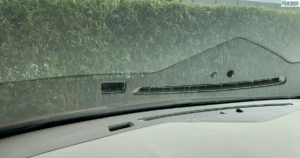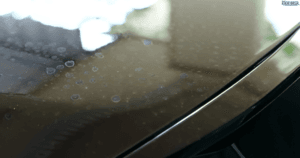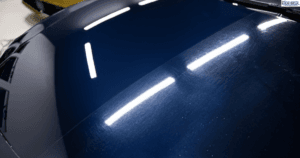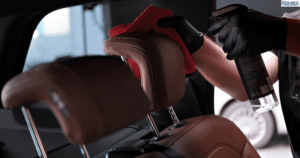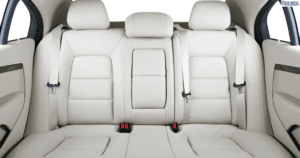If you love your car, chances are you’re looking for ways to keep it looking great for as long as possible. One of the most popular options for protecting the exterior of your car is Paint Protection Film (PPF). But there are a lot of questions that come with it—like whether it might damage your paint or how to handle that sticky adhesive when it comes time to remove it. In this blog, we’re going to answer these questions in simple terms to make sure you feel confident about PPF.
Does Paint Protection Film Damage Paint?
The short answer is: no, paint protection film does not damage your car’s paint. Instead, it helps preserve it by adding a layer of protection against all the elements that can damage it. Think of PPF as a shield for your car, it’s designed to keep scratches, small stones, UV rays, and other everyday wear and tear from damaging the beautiful paint underneath.
What Paint Protection Film is Safe for Your Paint
1. Quality Products Matter:
The most important factor to keep in mind is the quality of the film. High-quality PPF is made with advanced materials designed to be gentle on your car’s paint while being tough against scratches and chips. It’s like putting a high-quality screen protector on your phone. It protects without leaving a mark.
2. Expert Installation is Key:
Another important factor is the installation process. If applied by an experienced professional, the risk of damage is practically zero. Good installers know how to prepare the car’s surface properly, ensuring that the film sticks smoothly without any bubbles or rough spots. This process is essential because, when done correctly, the film will be easy to remove without causing any damage.
Related Blog: How to Apply Paint Protection Film (PPF)
When Problems Can Happen
While PPF generally doesn’t cause damage, there are a few things that can go wrong if the process isn’t done properly:
1. Low-Quality Film:
If a low-quality film is used, it may not adhere properly or might leave behind a sticky film, which can be tough to clean. Poor quality films can also be too rigid or hard to remove, which could lead to damage if you try to take it off.
2. Incorrect Installation:
If the PPF isn’t installed by a professional, there’s a risk of damaging the paint. Inexperienced technicians could stretch the film excessively or fail to properly clean the vehicle before applying it, which could cause problems when you try to remove it.
3. Harsh Removal:
Trying to pull the film off without proper techniques or tools can lead to paint peeling. We’ll go over the right way to remove it later in this blog.
Related Blog: How to Wash a Car with Paint Protection Film?
How to Remove Paint Protection Film Adhesive

If you’ve had your PPF on for a while, you may eventually need to remove it. Maybe it’s time for a new film, or you’re ready for a different kind of protection. Whatever the reason, one of the trickiest parts of removing PPF can be dealing with the leftover adhesive. If it’s not done right, the sticky film can be a real pain.
Let’s look at how you can safely remove that adhesive without damaging your paint.
Step 1: Prepare the Right Tools
Removing PPF adhesive requires the right tools. Here are some items you’ll need:
- Heat Gun or Hair Dryer: Heating the adhesive softens it, making it easier to peel away.
- Plastic Scraper or Credit Card: This helps lift the edge of the film without scratching the paint.
- Adhesive Remover: A good-quality automotive adhesive remover will help break down the sticky residue.
- Microfiber Towels: Soft towels to avoid scratches while cleaning.
Step 2: Warm Up the Adhesive
The first thing you should do is use heat to soften the glue. Warm up the PPF part you wish to remove with a hair dryer or heat gun set to low heat. Just enough heat should be applied to soften the adhesive without causing paint damage or film melting. Pulling off the film will be easier if you gently warm it up.
Step 3: Peel Off the Film Carefully
Peeling should begin at one of the PPF’s corners. To carefully raise the edge, use a plastic scraper or even a credit card. After lifting a corner, carefully remove the film with your hands. Pull slowly and at an angle while attempting to maintain constant pressure. Pulling it off quickly could harm the paint below, so you don’t want to do that.
Step 4: Use Adhesive Remover
After you’ve removed the film, you’ll probably see some adhesive left behind. This is where an adhesive remover comes in handy. Spray a bit of the adhesive remover onto the sticky areas and let it sit for a minute or two. After that, use a microfiber cloth to gently wipe away the residue. Don’t rub too hard; the adhesive should come off with light pressure.
Step 5: Clean the Surface
Once the adhesive is gone, it’s time to clean the surface. Use a standard car cleaning spray or even just soap and water to clean the area. This will help ensure that any leftover adhesive remover is taken off, leaving your paint shiny and smooth.
Read More: How Much to Tip a Car Detailer
Tips for Safely Removing PPF Adhesive
1. Don’t Rush:
The key to removing PPF and its adhesive without damaging the paint is to take your time. Work slowly, especially if you’re using heat. Moving too quickly can cause the film to tear or the paint to peel.
2. Avoid Sharp Tools:
Never use a sharp metal object to lift the film. It’s tempting to use something like a knife, but that will most certainly lead to scratches or chips in your paint.
3. Use Gentle Adhesive Removers:
Stick to adhesive removers that are designed for cars. Using household solvents like acetone can be too harsh and could damage your paint.
Common Mistakes to Avoid

1. Pulling Too Hard
It may be tempting to complete the PPF as quickly as possible, particularly if you’re having trouble getting started. But one of the most frequent causes of unintentional paint damage is pulling too quickly or too hard. In this race, slow and steady wins.
2. Skipping the Heat
If you try to remove PPF without softening the adhesive first, you’re asking for trouble.It will be more likely to remove some paint because the film will be tougher.
3. Not Using Adhesive Remover
Once the film is off, some people think they can just scrape off the adhesive. This is a bad idea. Without adhesive remover, the glue will likely smear or spread, making an even bigger mess.
Read More: How Long Does It Take to Polish a Car?
Wrapping It Up
Paint Protection Film is a fantastic way to protect your car’s paint from the elements, and with proper installation and care, it won’t damage your car. If the time comes when you need to remove it, just remember that patience and the right tools are key. By using heat, working slowly, and applying a gentle adhesive remover, you can get your car back to its original state without a hitch.
At Monster Detailing School, we believe that taking care of your car should be easy and accessible for everyone. Whether you’re considering PPF installation or removal of an old film, or even PPF training classes for yourself, having the right knowledge makes all the difference. If you have more questions or need professional help, feel free to reach out—we’re always here to help keep your ride looking its best!



